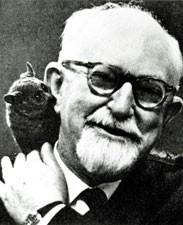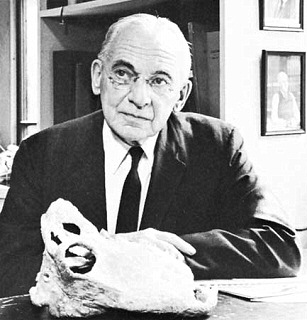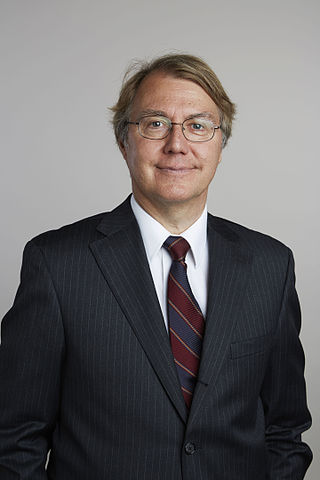Related Research Articles

A fossil is any preserved remains, impression, or trace of any once-living thing from a past geological age. Examples include bones, shells, exoskeletons, stone imprints of animals or microbes, objects preserved in amber, hair, petrified wood and DNA remnants. The totality of fossils is known as the fossil record.

George Gaylord Simpson was an American paleontologist. Simpson was perhaps the most influential paleontologist of the twentieth century, and a major participant in the modern synthesis, contributing Tempo and Mode in Evolution (1944), The Meaning of Evolution (1949) and The Major Features of Evolution (1953). He was an expert on extinct mammals and their intercontinental migrations. Simpson was extraordinarily knowledgeable about Mesozoic fossil mammals and fossil mammals of North and South America. He anticipated such concepts as punctuated equilibrium and dispelled the myth that the evolution of the horse was a linear process culminating in the modern Equus caballus. He coined the word hypodigm in 1940, and published extensively on the taxonomy of fossil and extant mammals. Simpson was influentially, and incorrectly, opposed to Alfred Wegener's theory of continental drift, but accepted the theory of plate tectonics when the evidence became conclusive.

Alfred Sherwood Romer was an American paleontologist and biologist and a specialist in vertebrate evolution.
Tempo and Mode in Evolution (1944) was George Gaylord Simpson's seminal contribution to the evolutionary synthesis, which integrated the facts of paleontology with those of genetics and natural selection.
Robert "Bob" Lynn Carroll was an American–Canadian vertebrate paleontologist who specialised in Paleozoic and Mesozoic amphibians and reptiles.

Preston Ercelle Cloud, Jr. was an American earth scientist, biogeologist, cosmologist, and paleontologist. He served in the United States Navy, and led several field explorations of the U.S. Geological Survey. In academia, he was a member of the faculty of Harvard University, University of Minnesota, University of California, Los Angeles, and lastly University of California, Santa Barbara. He was best known for his work on the geologic time scale and the origin of life on Earth, and as a pioneering ecologist and environmentalist. His works on the significance of Cambrian fossils in the 1940s led to the development of the concept "Cambrian explosion," for which he coined the phrase "eruptive evolution."
Prof David Meredith Seares Watson FRS FGS HFRSE LLD was the Jodrell Professor of Zoology and Comparative Anatomy at University College, London from 1921 to 1951.
Norman Dennis Newell was professor of geology at Columbia University, and chairman and curator of invertebrate paleontology at the American Museum of Natural History in New York City.

Amadeus William Grabau was an American geologist who worked in China.

Sir Arthur Smith Woodward, FRS was an English palaeontologist, known as a world expert in fossil fish. He also described the Piltdown Man fossils, which were later determined to be fraudulent. He is not related to Henry Woodward, whom he replaced as curator of the Geology Department of the British Museum of Natural History.

Paleobiology is an interdisciplinary field that combines the methods and findings found in both the earth sciences and the life sciences. Paleobiology is not to be confused with geobiology, which focuses more on the interactions between the biosphere and the physical Earth.

The University of California Museum of Paleontology (UCMP) is a paleontology museum located on the campus of the University of California, Berkeley.

The history of paleontology traces the history of the effort to understand the history of life on Earth by studying the fossil record left behind by living organisms. Since it is concerned with understanding living organisms of the past, paleontology can be considered to be a field of biology, but its historical development has been closely tied to geology and the effort to understand the history of Earth itself.

Andrew Herbert Knoll is the Fisher Research Professor of Natural History and a Research Professor of Earth and Planetary Sciences at Harvard University. Born in West Reading, Pennsylvania, in 1951, Andrew Knoll graduated from Lehigh University with a Bachelor of Arts in 1973 and received his Ph.D. from Harvard University in 1977 for a dissertation entitled "Studies in Archean and Early Proterozoic Paleontology." Knoll taught at Oberlin College for five years before returning to Harvard as a professor in 1982. At Harvard, he serves in the departments of Organismic and Evolutionary Biology and Earth and Planetary Sciences.
Steven M. Stanley is an American paleontologist and evolutionary biologist at the University of Hawaii at Manoa. He is best known for his empirical research documenting the evolutionary process of punctuated equilibrium in the fossil record.
The Daniel Giraud Elliot Medal is awarded by the U.S. National Academy of Sciences "for meritorious work in zoology or paleontology study published in a three- to five-year period." Named after Daniel Giraud Elliot, it was first awarded in 1917.
James William Schopf is an American paleobiologist and professor of earth sciences at the University of California Los Angeles. He is also Director of the Center for the Study of Evolution and the Origin of Life, and a member of the Department of Earth and Space Sciences, the Institute of Geophysics and Planetary Physics, and the Molecular Biology Institute at UCLA. He is most well known for his study of Precambrian prokaryotic life in Australia's Apex chert. Schopf has published extensively in the peer reviewed literature about the origins of life on Earth. He is the first to discover Precambrian microfossils in stromatolitic sediments of Australia (1965), South Africa (1966), Russia (1977), India (1978), and China (1984). He served as NASA's principal investigator of lunar samples during 1969–1974.

Anna Katherine "Kay" Behrensmeyer is an American taphonomist and paleoecologist. She is a pioneer in the study of the fossil records of terrestrial ecosystems and engages in geological and paleontological field research into the ecological context of human evolution in East Africa. She is Curator of Vertebrate Paleontology in the Department of Paleobiology at the Smithsonian Institution's National Museum of Natural History (NMNH). At the museum, she is co-director of the Evolution of Terrestrial Ecosystems program and an associate of the Human Origins Program.
The Raymond C. Moore Medal for Paleontology is awarded by the Society for Sedimentary Geology to persons who have made significant contributions in the field which have promoted the science of stratigraphy by research in paleontology and evolution and the use of fossils for interpretations of paleoecology. The award is named after Professor Raymond C. Moore, the American paleontogist who helped to found the society.
Susan M. Kidwell is an American paleontologist and geologist at the University of Chicago. Her research has focused on the relationships between fossil concentrations and sequence stratigraphy, experimental taphonomy, and the implications of the very recent fossil record for understanding modern ecological changes.
References
- ↑ "Mary Clark Thompson Medal". National Academy of Sciences. Retrieved 3 September 2015.
- ↑ "NAS Award in the Evolution of Earth and Life". NAS. Retrieved 24 April 2020.